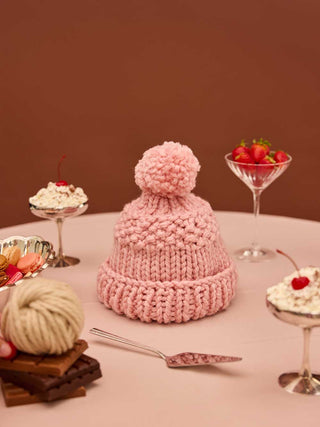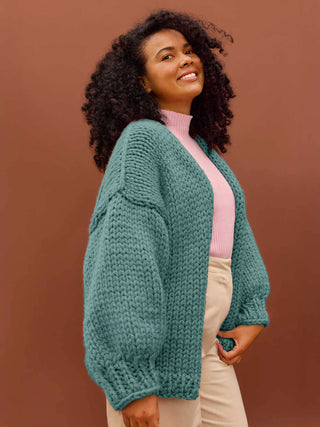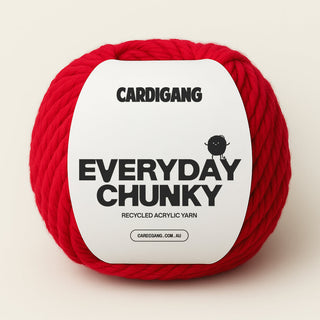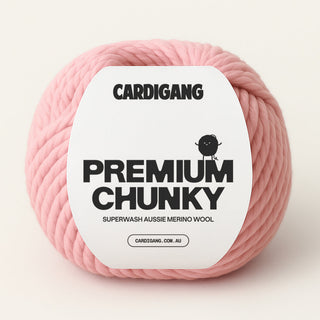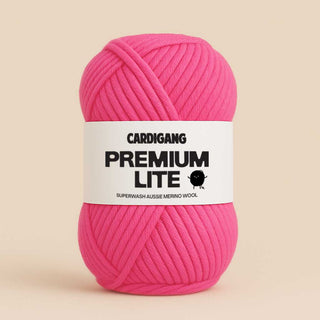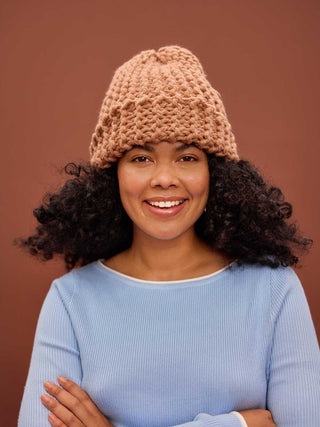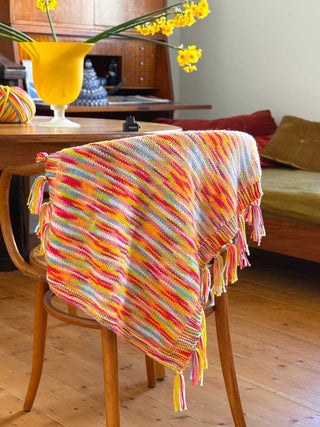A step-by-step guide to knitting the totally fine Frankie Tank
Ever gotten halfway through a project and thought “Hang on, am I even doing this right?” We have 🙋♀️
That’s why we’ve created these step-by-step guides to walk you through the knitting process.
Even if you've never knitted before, we'll take you from zero to knitting hero in no time 🦸♀️
When it comes to knitting, practice makes perfect
Before we get started on the pattern we suggest you spend a bit of time learning the basic stitches you’ll need to complete your masterpiece.
The Frankie Tank is the perfect beginner project because it's made up of 90% knit stitches - yep, just the one type of stitch will make up almost the whole tank top. We told you it was beginner-friendly 😎 You'll want to be confident with the knit stitch and its friend the purl stitch before we start. We put the knit and purl stitches together to make a rib stitch to begin. You'll also want to get a hang of tying a slip knot and casting on your stitches which is the first step in any knitting project.
You can use the yarn that came in your kit to practice with. Once you've got these mastered you'll find the pattern a cinch!
Total beginner? 👩🏫
For a more comprehensive lesson on the basics of knitting visit our Learn How To Knit page.
Onto the Tank!

Remember learning a new skill can be a little challenging at first, and you’re bound to find yourself making some mistakes along the way. But as with learning anything, your brain and your hands slowly start to get the hang of it, muscle memory is created, and soon the thing you found tricky/daunting/scary is like second nature! 💪
⚡️What you'll need
Your kit comes with everything you'll need to make your masterpiece. In your kit you'll find;
- 10mm (we use these for the rib at the bottom) and 15mm needles (we use these to complete the body)
- 3-4 balls of Cardigang Chunky Merino Wool
- A darning needle
- Made by me tag
You also want to have a pair of scissors handy.
📏 Sizing and measurements
You can make your Frankie Tank in 4 sizes.
| SIZE |
MEASUREMENTS (laying flat) |
| Small/1/6-8AU |
46cm wide x 42cm high (cropped 38cm high) |
| Medium/2/10-12AU |
52cm wide x 47cm high (cropped 43cm high) |
| Large/3/14-16 |
54cm wide x 52cm high (cropped 48cm high) |
| X Large/4/18-20 |
58cm wide x 56cm high (cropped 50cm high) |
Your pattern is read like this; 1 (2, 3, 4). Make sure you're following the correct instructions for your size.
🥣 Test your tension
Before you start your project, make sure your tension (how tightly or loosely your knitting is) is juuuust right. We do this by knitting a “tension swatch”. It's a bit like goldilocks, if the tension is too tight, your piece will be too small, and if it's too loose it may not hold its shape and might be too big.
Gauge: If done correctly, your 10x10cm knitted swatch should be 7 stitches wide and 12 rows high when knitted in garter stitch on your 15mm needles.
To test this, jump on your needles - use the yarn and needles that came in your kit. Cast on around 12-15 stitches, then knit in garter stitch (knit all stitches in every row) for around 12-16 rows. Then measure a 10x10cm square and count your stitches and rows within that space to make sure you're knitting at the correct tension.
If you've got more stitches or rows than the instructions say you should have, your knitting is a little too tight, and if you've got less your knitting is too loose. Adjust your tension by holding the yarn a little more tightly/loosely as you knit.

💡 We know knitting a tension swatch can seem like a bit of a drain, but it's really important because the difference of a few millimetres in your tension can lead to a finished piece this is quite different in size to what you intended.
🧶 Let's knit up a storm!
Time to get click-clacking and whip up your cosy tank top.

BACK
We start with the back panel, it’s the simplest piece of the knit and will give you confidence as you move onto other pieces. We knit from the bottom up, starting at the rib and going up to the shoulders.
Step 1:
Cast on the required number of stitches using your 10mm circular needles.
Step 2:
Once you've cast on the right number of stitches you move on to the rib. We knit the rib following the instructions in your pattern. To create a rib we knit 1 stitch, then purl the next, then knit the next, then purl the next and repeat.
🚨 Make sure you’re moving your yarn tail from the back to the front of your work between each stitch (bring the yarn in through the middle of the needles) to ensure the rib is executed correctly.
💭 Use the circles to tick off the rows as you go - this will help you keep track of your progress.
Step 3:
Next, we switch to using our 15mm straight needles and into garter stitch which is made when we knit every stitch in every row - simple!
💭 To switch to a different size needle we just hold the new needle (in this case the 15mm needle) in our right hand and the current needle with your work on it in your left hand. Then knit the stitches from your left needle onto the new needle in your right hand.
In this first row of garter stitch, we're also going to decrease the number of stitches on the row.
📹 Watch How To Knit Two Stitches Together
Step 4:
We’ll work the allocated rows of garter stitch - just keep knitting! 💪💪💪
Step 5-7:
This is where we begin to shape the back panel for the arm holes. Follow the instructions and decrease your stitches at the start and end of your row.
Step 8-10:
Okay, we're almost finished the back piece. It's at this point where we split the work to create the two shoulder straps and the gap for the head-hole. This means we will only knit some of the stitches on your needle before we turn our work and knit those same stitches again. The rest of your stitches will just hang out on your needle until we're ready to come back to them.
Knit up the first shoulder strap and then cast off your stitches.
Step 11-13:
Well done! You've done the first shoulder strap!
Time to rejoin our yarn and finish this piece. We rejoin our yarn by tying a knot to the bottom of the stitch on the closest to the end of your left needle.
First, we'll cast off some stitches to create the space for the head hold. Then we will shape the second shoulder.
FRONT
Good news! The front follows the same structure as the back in terms of techniques. So simply follow the pattern through cast-on, rib stitch, and garter stitch.
We'll start shaping the neckline on the front panel a few rows earlier than we did on the back but the process is the same.
SEWING IT TOGETHER
We're SO CLOSE! I can see the finish line 🎢🙌
Now it’s time to get to work with the darning needle to sew your masterpiece together. We lay our pieces flat and sew them together.
Step 1:
Lay your front and back pieces on a flat surface. Then sew the shoulder straps of the front and back panels together.
Step 2:
Next, we sew the sides of the top together. We lay the pieces flat so that the side seams are facing each other and starting from the rib at the bottom we sew up towards the armhole. You'll sew up to the point at which the tapering for the armhole starts.
For this step, we use a technique called mattress stitch. This technique is used when joining pieces vertically and it gives us a nice neat (almost) invisible join. It's also a great technique to hide loose or sloppy edges! 😎
You work this seam through the “bumps” of garter stitch.
📹 Watch How To Sew A Vertical Invisible Seam
💭 If you're anything like us you might find seaming a bit of a pain and hard to make super neat. It's a common beginner challenge! The main principle with seaming is no matter what seaming method you use, be sure you are entering into the same place on each stitch along the seam. This consistency makes it harder to see the seam.
💭 It's normal for the wool to get a bit shabby as you go, so we recommend using a few pieces and tying them together underneath as you go!
FINISHING
The last thing we do for every piece is weave in the ends. That’s basically just tidying up the piece so all loose ends are trimmed down and tucked into the inside of your work. You use your darning need and weave those ends into the seams so they are nicely hidden away.
D.O.N.E! You've finished your Frankie Tank, well done! Epic work 🤩 If this was your first-ever knitting project or one of many, we hope you had a blast click-clacking and making your masterpiece 💥❤️
In a bind and need a little more help?
Email us at stitchup@cardigang.com.au and we'll be able to help! Whether you're just starting out, or you've got a specific question or problem (dropped a stitch, no stress!), we're here to get you out of a bind.



